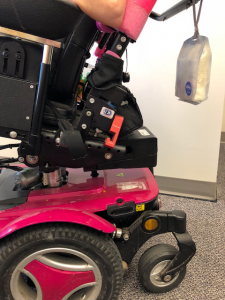Michelle L. Lange, OTR/L, ABDA, ATP/SMS
Can a Dynamic Back be used with any type of seat? Does the movement allowed by this component limit what seating surface can be used? This is an important consideration. A seat or cushion is typically designed to support the pelvis and provide pressure distribution when the client is in a static position. Dynamic seating gets things moving!Dynamic Backs allow posterior trunk movement, essentially opening the seat to back angle. The amount of movement varies between manufacturers, as does the pivot angle. The greater degree of movement, the more shear occurs, though this is primarily between the posterior pelvis and the back of the seating system. If the pivot point is high enough, posterior movement of back results in extension above the pelvis, rather than a change in angle between the pelvis and the thigh. This higher pivot point reduces shear and limits movement of the pelvis into a posterior tilt upon return to an upright seated posture.

The DRBi pivot point is designed to encourage trunk extension above the pelvis.
Dynamic Backs allow posterior trunk movement, essentially opening the seat to back angle. The amount of movement varies between manufacturers, as does the pivot angle. The greater degree of movement, the more shear occurs, though this is primarily between the posterior pelvis and the back of the seating system. If the pivot point is high enough, posterior movement of back results in extension above the pelvis, rather than a change in angle between the pelvis and the thigh. This higher pivot point reduces shear and limits movement of the pelvis into a posterior tilt upon return to an upright seated posture.
If the back does not have a large degree of posterior movement and the pivot point is higher, the pelvis will not move as much in relation to the seating surface. For example, the Seating Dynamics Dynamic Rocker Back interface (DRBi) only moves about 10 degrees and the pivot point is higher to keep the pelvis in position. This means that the type of seating surface is not as dependent on use with a Dynamic Back. With that said, if the cushion is not very stable, the pelvis is more likely to move out of a neutral position due to the movement of the Dynamic Back. Some cushions designed for moderate to maximum pressure distribution also tend to allow the pelvis to move within the cushion materials. This may not be a significant problem for a client with little volitional movement, such as a person with a high level spinal cord injury, but could be a problem for a client with strong and forceful movements, such as a person with cerebral palsy. Materials which may lead to loss of pelvic position when used in conjunction with a Dynamic back include air (i.e. Roho) and viscous fluids (i.e. Jay). This would need to be carefully assessed to determine if the seating materials are appropriate for use with Dynamic Seating as each individual, as well as their specific seating surface, is unique.
Some cushions provide significant posterior pelvic support, such as many of the Ride Designs cushions. Can these cushions be used with a Dynamic Back? If the pivot point is high, keeping the pelvis in a more neutral position during extension of the trunk, this posterior pelvic support is fine. As a matter of fact, this support actually encourages extension to occur above the pelvis to allow posterior movement of the trunk without loss of pelvic position in conjunction with the Dynamic Back.
Do you have further questions about seating systems, materials and Dynamic Seating? Give us a call and we would be happy to help you out.
** This post was originally published on https://www.seatingdynamics.com/2019/06/11/wheelchair-seating-surface-cushions-dynamic-seating/

